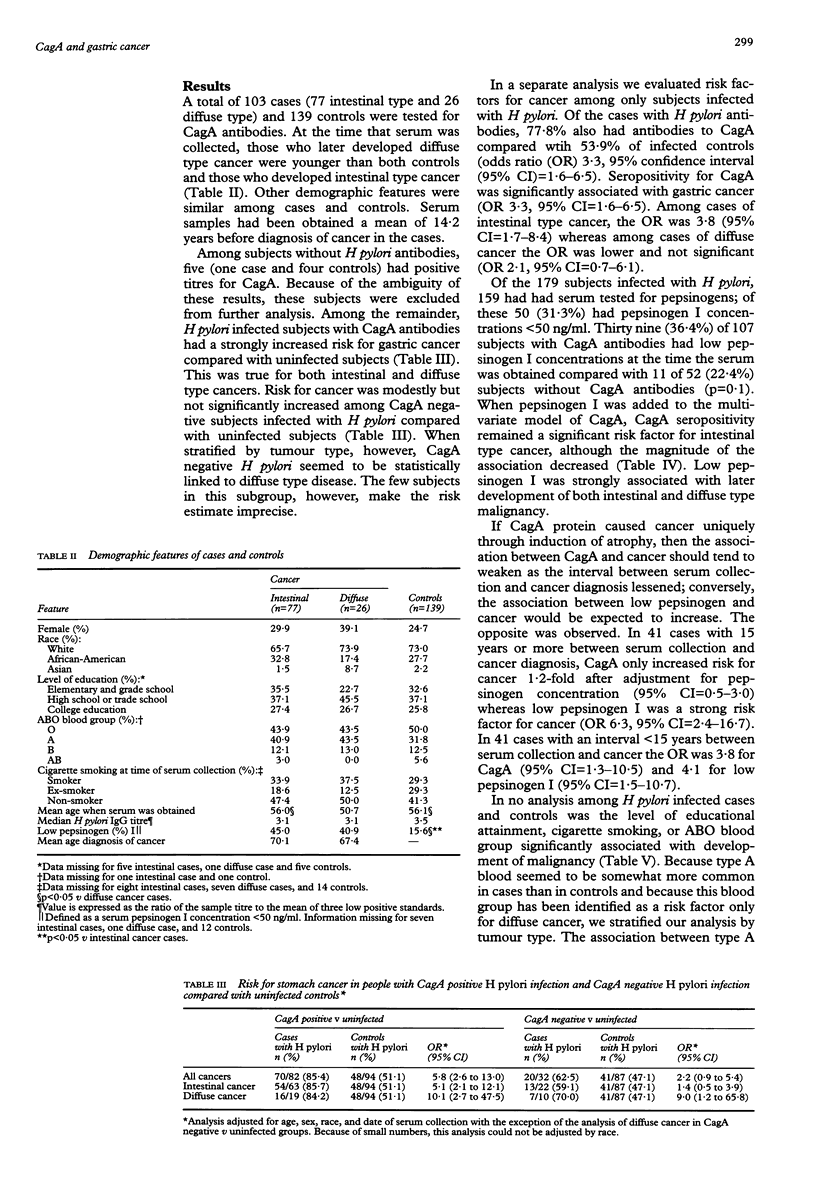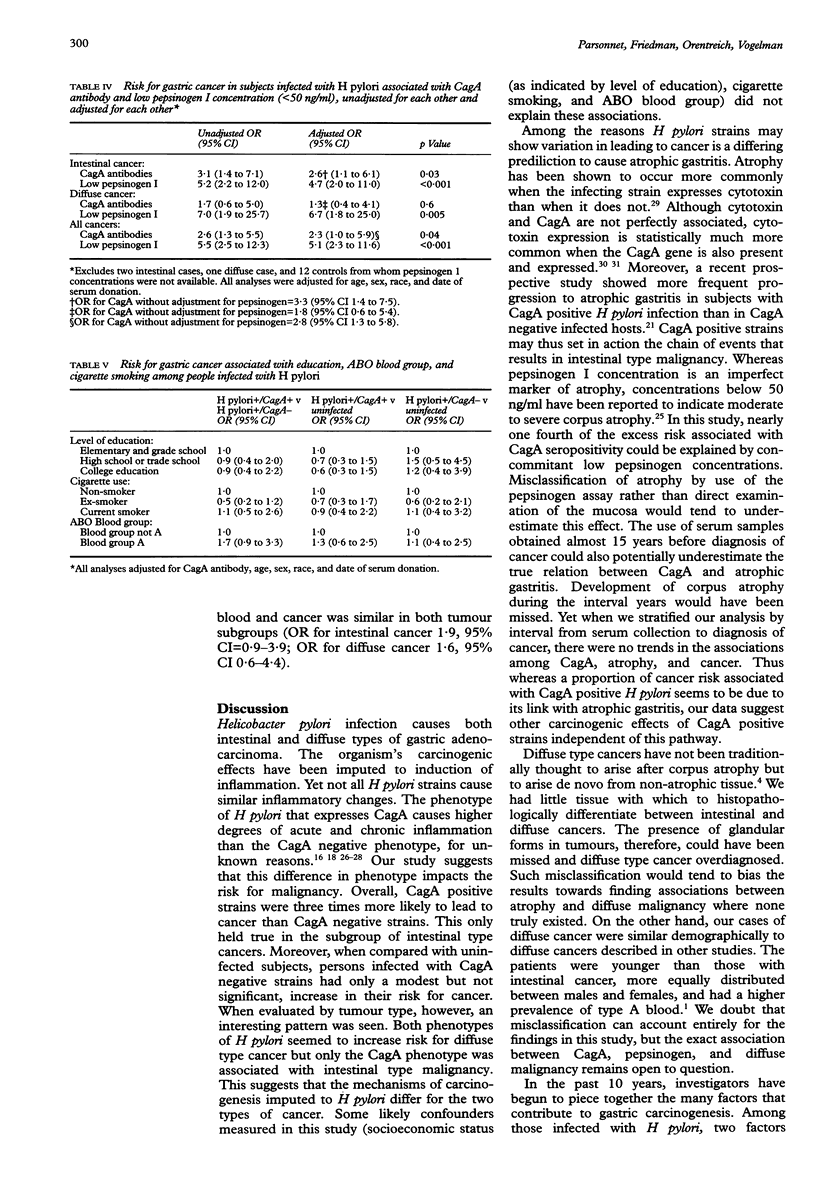Abstract
BACKGROUND AND AIMS: It is not known why some people with Helicobacter pylori infection develop gastric cancer whereas others do not. Whether the CagA phenotype of H pylori infection affected risk for cancer independently of other posited risk factors was evaluated. SUBJECTS: 242 persons who participated in a previous nested case-control study of gastric cancer. 179 (90 cases and 89 controls) were infected with H pylori as determined by enzyme linked immunosorbent assay (ELISA) in serum and 63 (13 cases and 50 controls) were uninfected. METHODS: Serum samples from cases and controls, obtained a mean of 14.2 years before diagnosis of cancer in the cases, were tested by ELISA for IgG antibodies against the CagA gene product of H pylori. They had previously been tested for pepsinogen I. Using logistic regression analysis, risk for cancer was compared among infected persons with CagA antibodies, infected persons without CagA antibodies, and uninfected persons. RESULTS: Subjects infected with H pylori who had CagA antibodies were 5.8-fold more likely than uninfected subjects to develop gastric cancer (95% confidence interval (95% CI) = 2.6-13.0). This was true for both intestinal (odds ratio (OR) 5.1, 95% CI = 2.1-12.2) and diffuse type (OR 10.1, 95% CI = 2.2-47.4) cancers. By contrast, H pylori infected subjects without CagA antibodies were only slightly, and not significantly, at increased risk for cancer (OR 2.2, 95% CI = 0.9-5.4) and any possible association was restricted to diffuse type carcinoma (OR 9.0, 95% CI = 1.2-65.8). Pepsinogen 1 < 50 ng/ml significantly increased risk for both cancer types in H pylori infected persons and lessened the magnitude of association between CagA and cancer. Educational attainment, cigarette smoking, and ABO blood group were not associated with malignancy. CONCLUSIONS: When compared with uninfected subjects, persons infected with CagA positive H pylori are at considerably increased risk of gastric cancer. CagA negative H pylori are less strongly linked to malignancy and may only be associated with diffuse type disease.
Full text
PDF




Selected References
These references are in PubMed. This may not be the complete list of references from this article.
- Atherton J. C., Cao P., Peek R. M., Jr, Tummuru M. K., Blaser M. J., Cover T. L. Mosaicism in vacuolating cytotoxin alleles of Helicobacter pylori. Association of specific vacA types with cytotoxin production and peptic ulceration. J Biol Chem. 1995 Jul 28;270(30):17771–17777. doi: 10.1074/jbc.270.30.17771. [DOI] [PubMed] [Google Scholar]
- Blaser M. J. Helicobacter pylori phenotypes associated with peptic ulceration. Scand J Gastroenterol Suppl. 1994;205:1–5. [PubMed] [Google Scholar]
- Blaser M. J. Intrastrain differences in Helicobacter pylori: a key question in mucosal damage? Ann Med. 1995 Oct;27(5):559–563. doi: 10.3109/07853899509002469. [DOI] [PubMed] [Google Scholar]
- Blaser M. J., Perez-Perez G. I., Kleanthous H., Cover T. L., Peek R. M., Chyou P. H., Stemmermann G. N., Nomura A. Infection with Helicobacter pylori strains possessing cagA is associated with an increased risk of developing adenocarcinoma of the stomach. Cancer Res. 1995 May 15;55(10):2111–2115. [PubMed] [Google Scholar]
- Borch K., Axelsson C. K., Halgreen H., Damkjaer Nielsen M. D., Ledin T., Szesci P. B. The ratio of pepsinogen A to pepsinogen C: a sensitive test for atrophic gastritis. Scand J Gastroenterol. 1989 Sep;24(7):870–876. doi: 10.3109/00365528909089228. [DOI] [PubMed] [Google Scholar]
- Borch K., Axelsson C. K., Halgreen H., Damkjaer Nielsen M. D., Ledin T., Szesci P. B. The ratio of pepsinogen A to pepsinogen C: a sensitive test for atrophic gastritis. Scand J Gastroenterol. 1989 Sep;24(7):870–876. doi: 10.3109/00365528909089228. [DOI] [PubMed] [Google Scholar]
- Borén T., Falk P., Roth K. A., Larson G., Normark S. Attachment of Helicobacter pylori to human gastric epithelium mediated by blood group antigens. Science. 1993 Dec 17;262(5141):1892–1895. doi: 10.1126/science.8018146. [DOI] [PubMed] [Google Scholar]
- Cover T. L., Glupczynski Y., Lage A. P., Burette A., Tummuru M. K., Perez-Perez G. I., Blaser M. J. Serologic detection of infection with cagA+ Helicobacter pylori strains. J Clin Microbiol. 1995 Jun;33(6):1496–1500. doi: 10.1128/jcm.33.6.1496-1500.1995. [DOI] [PMC free article] [PubMed] [Google Scholar]
- Cover T. L., Tummuru M. K., Cao P., Thompson S. A., Blaser M. J. Divergence of genetic sequences for the vacuolating cytotoxin among Helicobacter pylori strains. J Biol Chem. 1994 Apr 8;269(14):10566–10573. [PubMed] [Google Scholar]
- Crabtree J. E., Covacci A., Farmery S. M., Xiang Z., Tompkins D. S., Perry S., Lindley I. J., Rappuoli R. Helicobacter pylori induced interleukin-8 expression in gastric epithelial cells is associated with CagA positive phenotype. J Clin Pathol. 1995 Jan;48(1):41–45. doi: 10.1136/jcp.48.1.41. [DOI] [PMC free article] [PubMed] [Google Scholar]
- Crabtree J. E., Taylor J. D., Wyatt J. I., Heatley R. V., Shallcross T. M., Tompkins D. S., Rathbone B. J. Mucosal IgA recognition of Helicobacter pylori 120 kDa protein, peptic ulceration, and gastric pathology. Lancet. 1991 Aug 10;338(8763):332–335. doi: 10.1016/0140-6736(91)90477-7. [DOI] [PubMed] [Google Scholar]
- Desai M., Linton D., Owen R. J., Cameron H., Stanley J. Genetic diversity of Helicobacter pylori indexed with respect to clinical symptomatology, using a 16S rRNA and a species-specific DNA probe. J Appl Bacteriol. 1993 Dec;75(6):574–582. doi: 10.1111/j.1365-2672.1993.tb01597.x. [DOI] [PubMed] [Google Scholar]
- Engstrom P. F. Predictors of future breast cancer risk. Cancer Epidemiol Biomarkers Prev. 1993 Jan-Feb;2(1):1–2. [PubMed] [Google Scholar]
- Fox J. G., Correa P., Taylor N. S., Thompson N., Fontham E., Janney F., Sobhan M., Ruiz B., Hunter F. High prevalence and persistence of cytotoxin-positive Helicobacter pylori strains in a population with high prevalence of atrophic gastritis. Am J Gastroenterol. 1992 Nov;87(11):1554–1560. [PubMed] [Google Scholar]
- Hansson L. E., Baron J., Nyrén O., Bergström R., Wolk A., Adami H. O. Tobacco, alcohol and the risk of gastric cancer. A population-based case-control study in Sweden. Int J Cancer. 1994 Apr 1;57(1):26–31. doi: 10.1002/ijc.2910570106. [DOI] [PubMed] [Google Scholar]
- Howson C. P., Hiyama T., Wynder E. L. The decline in gastric cancer: epidemiology of an unplanned triumph. Epidemiol Rev. 1986;8:1–27. doi: 10.1093/oxfordjournals.epirev.a036288. [DOI] [PubMed] [Google Scholar]
- Huang J., O'Toole P. W., Doig P., Trust T. J. Stimulation of interleukin-8 production in epithelial cell lines by Helicobacter pylori. Infect Immun. 1995 May;63(5):1732–1738. doi: 10.1128/iai.63.5.1732-1738.1995. [DOI] [PMC free article] [PubMed] [Google Scholar]
- Kekki M., Samloff I. M., Varis K., Ihamäki T. Serum pepsinogen I and serum gastrin in the screening of severe atrophic corpus gastritis. Scand J Gastroenterol Suppl. 1991;186:109–116. doi: 10.3109/00365529109103997. [DOI] [PubMed] [Google Scholar]
- Kneller R. W., You W. C., Chang Y. S., Liu W. D., Zhang L., Zhao L., Xu G. W., Fraumeni J. F., Jr, Blot W. J. Cigarette smoking and other risk factors for progression of precancerous stomach lesions. J Natl Cancer Inst. 1992 Aug 19;84(16):1261–1266. doi: 10.1093/jnci/84.16.1261. [DOI] [PubMed] [Google Scholar]
- Kuipers E. J., Pérez-Pérez G. I., Meuwissen S. G., Blaser M. J. Helicobacter pylori and atrophic gastritis: importance of the cagA status. J Natl Cancer Inst. 1995 Dec 6;87(23):1777–1780. doi: 10.1093/jnci/87.23.1777. [DOI] [PubMed] [Google Scholar]
- Mentis A., Blackwell C. C., Weir D. M., Spiliadis C., Dailianas A., Skandalis N. ABO blood group, secretor status and detection of Helicobacter pylori among patients with gastric or duodenal ulcers. Epidemiol Infect. 1991 Apr;106(2):221–229. doi: 10.1017/s0950268800048366. [DOI] [PMC free article] [PubMed] [Google Scholar]
- Nomura A. M., Stemmermann G. N., Chyou P. H. Gastric cancer among the Japanese in Hawaii. Jpn J Cancer Res. 1995 Oct;86(10):916–923. doi: 10.1111/j.1349-7006.1995.tb03001.x. [DOI] [PMC free article] [PubMed] [Google Scholar]
- Nomura A., Stemmermann G. N., Chyou P. H., Kato I., Perez-Perez G. I., Blaser M. J. Helicobacter pylori infection and gastric carcinoma among Japanese Americans in Hawaii. N Engl J Med. 1991 Oct 17;325(16):1132–1136. doi: 10.1056/NEJM199110173251604. [DOI] [PubMed] [Google Scholar]
- Nomura A., Stemmermann G. N., Chyou P. H., Kato I., Perez-Perez G. I., Blaser M. J. Helicobacter pylori infection and gastric carcinoma among Japanese Americans in Hawaii. N Engl J Med. 1991 Oct 17;325(16):1132–1136. doi: 10.1056/NEJM199110173251604. [DOI] [PubMed] [Google Scholar]
- Parsonnet J., Friedman G. D., Vandersteen D. P., Chang Y., Vogelman J. H., Orentreich N., Sibley R. K. Helicobacter pylori infection and the risk of gastric carcinoma. N Engl J Med. 1991 Oct 17;325(16):1127–1131. doi: 10.1056/NEJM199110173251603. [DOI] [PubMed] [Google Scholar]
- Peek R. M., Jr, Miller G. G., Tham K. T., Perez-Perez G. I., Zhao X., Atherton J. C., Blaser M. J. Heightened inflammatory response and cytokine expression in vivo to cagA+ Helicobacter pylori strains. Lab Invest. 1995 Dec;73(6):760–770. [PubMed] [Google Scholar]
- Sharma S. A., Tummuru M. K., Miller G. G., Blaser M. J. Interleukin-8 response of gastric epithelial cell lines to Helicobacter pylori stimulation in vitro. Infect Immun. 1995 May;63(5):1681–1687. doi: 10.1128/iai.63.5.1681-1687.1995. [DOI] [PMC free article] [PubMed] [Google Scholar]
- Taylor D. E., Eaton M., Chang N., Salama S. M. Construction of a Helicobacter pylori genome map and demonstration of diversity at the genome level. J Bacteriol. 1992 Nov;174(21):6800–6806. doi: 10.1128/jb.174.21.6800-6806.1992. [DOI] [PMC free article] [PubMed] [Google Scholar]
- Telford J. L., Covacci A., Ghiara P., Montecucco C., Rappuoli R. Unravelling the pathogenic role of Helicobacter pylori in peptic ulcer: potential new therapies and vaccines. Trends Biotechnol. 1994 Oct;12(10):420–426. doi: 10.1016/0167-7799(94)90031-0. [DOI] [PubMed] [Google Scholar]
- Xiang Z., Censini S., Bayeli P. F., Telford J. L., Figura N., Rappuoli R., Covacci A. Analysis of expression of CagA and VacA virulence factors in 43 strains of Helicobacter pylori reveals that clinical isolates can be divided into two major types and that CagA is not necessary for expression of the vacuolating cytotoxin. Infect Immun. 1995 Jan;63(1):94–98. doi: 10.1128/iai.63.1.94-98.1995. [DOI] [PMC free article] [PubMed] [Google Scholar]
- Xiang Z., Censini S., Bayeli P. F., Telford J. L., Figura N., Rappuoli R., Covacci A. Analysis of expression of CagA and VacA virulence factors in 43 strains of Helicobacter pylori reveals that clinical isolates can be divided into two major types and that CagA is not necessary for expression of the vacuolating cytotoxin. Infect Immun. 1995 Jan;63(1):94–98. doi: 10.1128/iai.63.1.94-98.1995. [DOI] [PMC free article] [PubMed] [Google Scholar]


